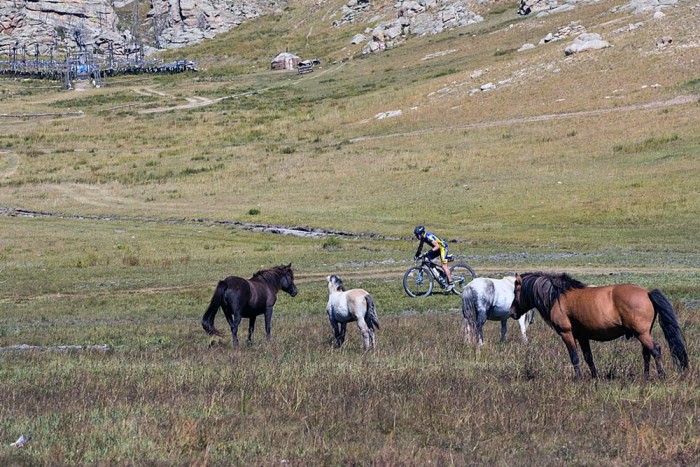A bewildering number of mountain bike stage races exist across six continents. Some claim to be the toughest, others the most scenic, while a few boast of being the greatest. Nevertheless, one race which appears to stand alone, in extraordinary ways, is the Mongolian Bike Challenge. Having raced the event in 2013, Phil Welch explains some of the reasons it ought to be at the top of any competitive mountain biker’s bucket list.
A Landlocked Natural Wonderland
In 2013, the population of Mongolia was a mere 2.9 million, making it the least densely populated and one of the least developed countries in the world. Over half the country (52 per cent) is grassland and shrubs, the steppes stretching infinitely in all directions. 32 per cent of the country is desert, with the Gobi Desert, in Mongolia’s south, being the fifth largest desert in the world. 15 per cent is forest and just 1 per cent is utilised for human settlement and crop cultivation.
After independence from Russia in 1990, it was hoped the entire country could be turned into a National Park. This goal was to prove unattainable but in a relatively short time over 13 per cent of the nation has been protected including 48 separate areas. The government aims to protect a third of the country, which would mean Mongolia would possess the largest park system in the world.
Hospitality to warm the coldest of temperatures
Mongolia is extremely cold in winter but fortunately, the Mongolian Bike Challenge takes place in September, when average temperatures range from -5 degrees C at night to 22 degrees C during the day with 12 hours of daylight and, although thunderstorms are possible, light rain is more likely.
Mongolia is one of the most beautiful and hospitable countries on earth. Beyond the chaos of Ulaanbaatar, the capital city and arrival point for foreign visitors, lies vast expanses of pristine wilderness. The remoteness of the people has meant Mongolians follow simple nomadic lifestyles, where living conditions are rustic and unsophisticated. The home is still the Ger (or Yurt), a fur-lined tent where family members are forced to interact, share everything and work together resulting in tighter relationships between relatives.
The Yurt or Ger. The traditional home of Mongolia’s nomadic population.
Nomads are likely to move 2-4 times a year but where grass is thin this may increase. The diet consists of mainly dairy products and meat (especially mutton), animal organs, intestines and even the head (Ed. – This all forms part of the MBC experience). Mongolian airag, made from fermented mare’s milk, is often drunk. Local roads are undeveloped and road signs virtually non-existent.
Extraordinary home to extraordinary fauna
Mongolia is a naturalist’s dream and is the last bastion of unspoiled land in Asia. Numerous species, only found in Mongolia and Central Asia, are often sighted by riders competing at the Mongolia Bike Challenge.
The Bactrian Camel is a two humped cantankerous beast with a shaggy wool coat which can survive a week without water and a month without food. There are 260,000 camels in Mongolia with over two thirds found in the Gobi Desert region.
Takhi (Przewalski’s) Horse: These wild horses became extinct in Mongolia in 1968 due, in part, to barbaric and extensive hunting funded by foreigners. Fortunately, a Russian army officer, Przewlski (1839-1888) had initiated a campaign to remove Takhi foals from their native Mongolia. This allowed 84 wild horses to be reintroduced between 1992 and 2000 with the help of government funding from the Netherlands. Now herds numbering 200 can be seen. Their reintroduction has been described as nothing short of miraculous, representing one of the most successful conservation stories of our time.
The Bactrian Camel and Takhi Horse. Just two of the amazing animals to be found roaming the Mongolian plains.
Gazelle are often seen on the Mongolian Steppe and represent one of the last remaining migratory herds.
It may also be possible to see the Cinereous Vulture, the largest raptor in Central Asia, the Sakar Falcon, smuggled to the Gulf states and used for sport, the Black Kite, which will often swoop down and catch bread thrown high into the air, hawks, eagles, owls, upland buzzards and the colourful hoopoes.
Several species of animal are seriously endangered including the Argali Sheep, Saiga Antelope, the Snow Leopard, wild asses, and the Gobi Bear, the world’s only desert-dwelling bear. Animals found in forest regions include the Siberian Ibex, the Brown Bear, Wild Boar and wolves.
True adventure
The Mongolian Bike Challenge is a race like no other. Located in a country where time appears to have stood still, in a land which remains as pristine as it was a thousand years ago and inhabited by unique animals found nowhere else in the world. The majority of people continue to live like our distant ancestors lived, in simple dwellings without most of the trappings of our modern everyday lives.
It’s a country where nature is king, in the form of the vast plains and majestic mountains, with a climate that is constantly changing and imposing its will on her people. At first glance, it may appear an unlikely place for a bike race, and yet its very real majesty goes straight to the heart of why we ride. This is a place of true adventure. Those who choose to take up the Mongolian Bike Challenge will return with memories of this extraordinary land forever etched in their minds.
The 8-stage race takes place from August 21-30, 2015. It covers 856km and over 13,000m of climbing. Entries are open now, visit here to learn more or enter the race.

